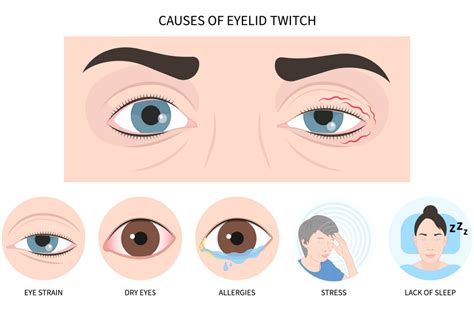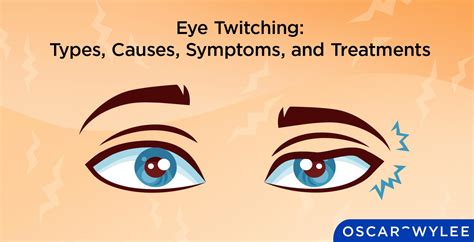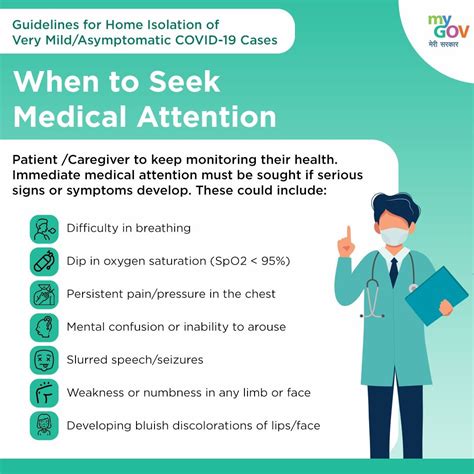Intro
Discover the underlying eyelid twitching causes, including fatigue, stress, and eye strain, and learn how to alleviate symptoms with natural remedies and lifestyle changes.
Eyelid twitching, also known as eyelid spasms or myokymia, is a common condition that affects millions of people worldwide. It is characterized by involuntary twitching or spasms of the eyelid muscles, which can be frustrating and annoying for those who experience it. In most cases, eyelid twitching is harmless and resolves on its own without any treatment. However, in some cases, it can be a symptom of an underlying condition that requires medical attention. In this article, we will delve into the causes of eyelid twitching, its symptoms, and possible treatments.
Eyelid twitching can be caused by a variety of factors, including fatigue, stress, and eye strain. When we are tired or stressed, our muscles can become tense and twitchy, leading to eyelid spasms. Similarly, prolonged use of computers or other digital devices can cause eye strain, which can lead to eyelid twitching. Other possible causes of eyelid twitching include caffeine, nicotine, and other stimulants, which can increase muscle activity and lead to twitching. In some cases, eyelid twitching can be a symptom of a neurological disorder, such as blepharospasm or hemifacial spasm, which requires medical attention.
The symptoms of eyelid twitching can vary from person to person, but common symptoms include involuntary twitching or spasms of the eyelid muscles, which can be mild or severe. In some cases, the twitching can be so severe that it interferes with daily activities, such as reading or driving. Other symptoms of eyelid twitching include eye irritation, dryness, or redness, which can be caused by the constant twitching and spasming of the eyelid muscles. In rare cases, eyelid twitching can be a symptom of a more serious condition, such as a brain or nerve disorder, which requires immediate medical attention.
Eyelid Twitching Causes

Common Causes of Eyelid Twitching
Some common causes of eyelid twitching include: * Fatigue and lack of sleep * Stress and anxiety * Eye strain and prolonged use of digital devices * Caffeine and nicotine consumption * Magnesium or potassium deficiency * Blepharospasm or hemifacial spasm * Other neurological disordersTypes of Eyelid Twitching

Treatments for Eyelid Twitching
Treatments for eyelid twitching depend on the underlying cause of the condition. In most cases, eyelid twitching can be treated with lifestyle changes, such as getting enough sleep, reducing stress, and avoiding eye strain. In some cases, medication or surgery may be necessary to treat underlying conditions, such as blepharospasm or hemifacial spasm. Other treatments for eyelid twitching include botulinum toxin injections, which can help to relax the eyelid muscles and reduce twitching.Home Remedies for Eyelid Twitching

Prevention of Eyelid Twitching
Preventing eyelid twitching involves making lifestyle changes, such as getting enough sleep, reducing stress, and avoiding eye strain. Other ways to prevent eyelid twitching include avoiding caffeine and nicotine, taking regular breaks when working on computers or other digital devices, and practicing relaxation techniques, such as meditation or deep breathing.When to Seek Medical Attention

Diagnosis of Eyelid Twitching
Diagnosing eyelid twitching involves a physical examination and a review of your medical history. Your doctor may also perform tests, such as a neurological examination or imaging studies, to rule out underlying conditions, such as blepharospasm or hemifacial spasm.Treatment Options for Eyelid Twitching

Living with Eyelid Twitching
Living with eyelid twitching can be challenging, but there are several ways to manage the condition and reduce its impact on daily life. This includes making lifestyle changes, such as getting enough sleep, reducing stress, and avoiding eye strain. Other ways to manage eyelid twitching include practicing relaxation techniques, such as meditation or deep breathing, and taking regular breaks when working on computers or other digital devices.Conclusion and Final Thoughts

We hope this article has provided you with a comprehensive understanding of eyelid twitching, its causes, symptoms, and treatment options. If you have any questions or comments, please feel free to share them with us. We would love to hear from you and help you in any way we can.
What are the common causes of eyelid twitching?
+Common causes of eyelid twitching include fatigue, stress, eye strain, caffeine, and nicotine consumption, as well as magnesium or potassium deficiency.
How can I treat eyelid twitching at home?
+You can treat eyelid twitching at home by applying a warm compress to the affected eye, getting enough sleep, reducing stress, and avoiding eye strain.
When should I seek medical attention for eyelid twitching?
+You should seek medical attention if you experience severe or persistent eyelid twitching, eye pain or vision changes, facial weakness or numbness, or difficulty speaking or swallowing.
